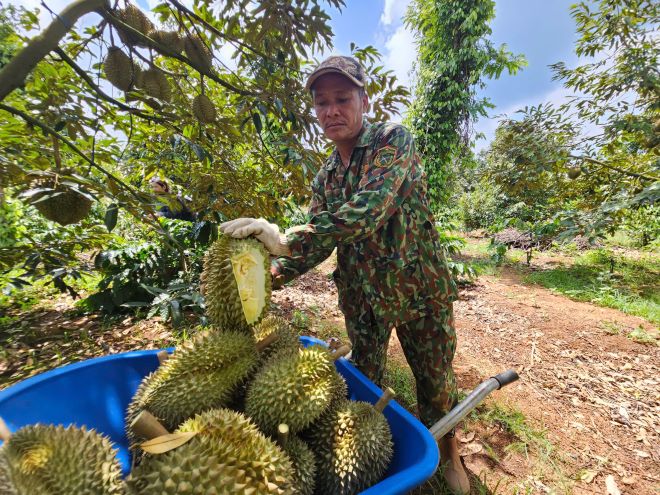Concerns about the origin of Cadimi
Where does Cadimi come from? This is a huge concern for durian growers in Dak Lak. Because recently, many Vietnamese durian batches have been returned by China due to the Cadimi content exceeding the threshold.
Mr. Nguyen Van Ha, Deputy Director of the Department of Agriculture and Environment of Dak Lak, said that in the first 6 months of 2025, durian export activities have seriously decreased.
Many shipments to China were returned due to contamination with banned substances, leading to a sharp decrease in durian prices compared to the same period in 2024. In some regions, durian prices have decreased by 40-50%.
Farmer Nguyen Vanem (Cu Pong commune, Krong Buk district) shared that he currently has 2 hectares of durian. There are about 3 months left until the garden is ready for harvest, but Mr. hes is very worried about the banned substance Cadimi.
"I grow durian based on experience and learn from others, apply the care methods, fertilizers, and pesticides they use. Now that I heard about the Cadimi banned substance, I don't know where it came from," Mr. Them shared.
Not only Mr.em but many durian farmers also want to know the cause of Cadimi's appearance to take response measures.

Regarding this issue, Prof. Dr. Tran Van Hau - former senior lecturer at Can Tho University said that Cadimi is a toxic heavy metal that not only affects human health but also reduces crop productivity.
Cadimi comes from both nature and human activity. Natural resources are mainly from ore, while man-made sources come from industrial activities such as battery and fertilizer production.
Areas with industrial activities or mineral exploitation with a high risk of Cadimi remnants in soil and water.

According to Prof. Dr. Tran Van Hau and Cadimi are also accumulated through the process of fertilization and the use of pesticides. Cadimi is especially common in lion droppings (this type of dropping contains phosphorus).
Farmers often use the most elephant manure during the flower budding period to increase the likelihood of producing fruit. Sometimes when the weather is unfavorable, you have to pick the flower buds many times, which means using a large amount of lion manure.
Depending on the soil condition, if the soil is too sour (low pH), it will create conditions for Cadimi to dissolve and be more easily absorbed by plants, leading to the risk of Cadimi accumulating in durian.
How to remove banned substances right from the growing area
To control Cadimi waste, according to Mr. Hau, farmers need to take practical measures. First, it is necessary to increase the pH of the soil to limit Cadimi and improve nutrient absorption.
Use the right dosage of lion manure, increase the use of organic manure grown from biological waste...
In addition, specialized agencies need to comprehensively assess the level of Cadimi pollution in land in key growing areas. Large farms should proactively take soil samples for periodic testing to monitor Cadimi residues and take timely adjustment measures.
Dak Lak province is determined to say no to the banned substances in durian. To control Cadimi for the upcoming harvest, the Department of Agriculture and Environment will coordinate with the durian Association and related units to take soil samples for inspection.
Before harvesting, it will be checked again to ensure the product is safe. In the long term, Dak Lak will build a standard production process to control banned substances and aim for sustainable production.
The country currently has about 178,800 hectares of durian, of which Dak Lak leads the country with 38,800 hectares. In 2025, the province is estimated to harvest about 400,000 tons of durian.











